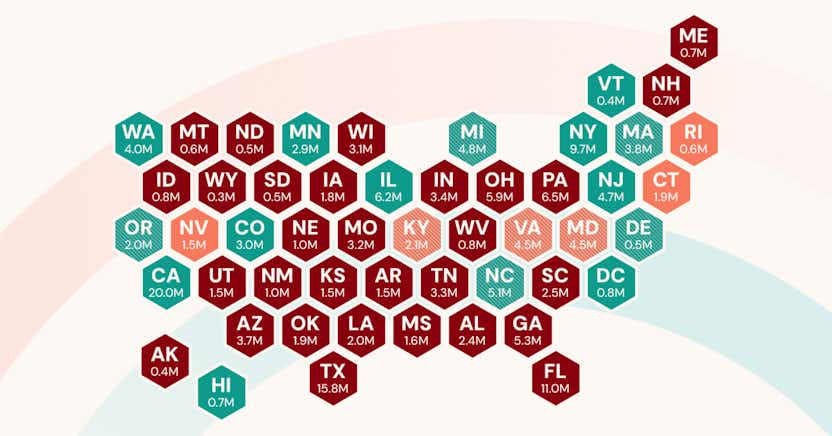Understanding Pay Equity: How to Address Pay Disparities through HR Processes

Learn more about the following beqom products
With employee turnover on the rise, pay equity has a business necessity, in addition to being a key factor in governance, risk, and compliance. Organizations that prioritize equitable compensation practices not only create trust but also enhance employee satisfaction, retention, and reputation.
This article discusses the critical differences between pay equity and pay equality, highlights the organizational and societal benefits of equitable pay, and outlines actionable steps HR teams can take to identify and address disparities. From conducting pay audits to leveraging advanced HR software, you will learn how to embed pay equity into your organization’s DNA and create a workplace where fairness and success go hand in hand.
What is pay equity?
Pay equity ensures all employees are compensated fairly, according to merit, regardless of gender, age, race, sexual orientation, disability, or other factors. It’s about evaluating roles, responsibilities, and contributions and compensating employees equitably without bias. This concept forms the foundation for building inclusive and sustainable workplaces.
What is the difference between pay equity and pay equality?
When discussing fair compensation, the terms pay equity and pay equality are often used interchangeably. While both are important and share similarities, organizations must understand their distinct meanings and differences.
- Pay equality ensures equal pay for employees performing the same or equivalent work. For instance, male and female employees in the same role are compensated equally.
- Pay equity goes a step further by addressing systemic biases, structural barriers, and hidden inequities. It considers the broader organizational context, such as underrepresentation in leadership roles or biases in promotion opportunities, that impact earning potential.
Paying male and female employees the same for comparable work is a step towards fair compensation, but if women within the organization are underrepresented in leadership roles, the system may still be inequitable, as it does not address the broader challenges that impact their career advancement and earning potential.
As this example demonstrates, achieving pay equity is far more challenging than equality, as rather than simply comparing compensation between demographics to identify and fix disparities for equality, equity requires a more in-depth analysis of the organization’s processes, from candidate selection and recruitment practices to promotions and bonus allocation.
How pay equity impacts organizations
Although achieving equitable pay can be challenging, organizations can use pay equity strategically to gain personal benefits such as:
- Attract Talent: Competitive and equitable pay structures draw top talent, particularly in competitive markets.
- Enhance Reputation: Publicly committing to pay equity improves an organization’s image among customers, investors, and potential hires.
- Increase Retention: Employees who perceive their compensation as fair are more likely to remain loyal, reducing turnover.
- Mitigate Legal Risks: Proactively addressing pay gaps minimizes the likelihood of lawsuits and compliance issues.
- Raise Morale: Transparent pay practices build trust, showing employees that their contributions are valued and fairly compensated. This trust translates into higher engagement and productivity.
- Strengthen Corporate Culture: Equitable compensation practices demonstrate a company’s commitment to fairness, reinforcing a positive and inclusive workplace environment.
Why is pay equity important?
The importance of pay equity extends past organizational benefits and towards positive societal impacts.
Pay equity enhances talent recruitment by expanding access to a more diverse labor market. When organizations commit to fair compensation, they attract candidates from a wide range of backgrounds who feel confident that their skills and experience will be valued. This fosters a more inclusive workplace, where individuals from underrepresented groups have equal opportunities to contribute and grow.
While diversity, equity, and inclusion programs have come under recent scrutiny, the fact remains that diverse teams are proven to drive innovation, as different perspectives can lead to more creative and effective problem-solving due to people from various ethnic, gender, or cultural backgrounds bringing unique insights and knowledge.
Pay equity is not just about fairness; it’s a business imperative. Companies that prioritize equitable practices often outperform their competitors. Here’s why:
- Attracting Niche Talent: In sectors like technology and healthcare, specialized skills are in demand.
- Driving Sustainability: Organizations aligned with equity goals tend to focus on long-term employee satisfaction, reducing the hidden costs of turnover, such as recruitment and training expenses.
- Reinforcing Corporate Social Responsibility: Companies embracing pay equity send a clear message of inclusivity, which aligns with the values of socially-conscious consumers and investors.
Pay equity regulations
Pay equity is mandated by law in many regions. Laws like the Equal Pay Act of 1963 in the U.S. and the Corporate Sustainability Reporting Directive (CSRD) in the EU require organizations to ensure fair compensation practices. Similarly, U.S. organizations operating in the European Union must comply with the EU Pay Transparency Directive, which requires reporting gender pay gaps and other compensation data.

A Guide to the EU Pay Transparency Directive
Understand and prepare for the Directive to save time, ensure compliance, and create a culture of fairness in your organization.
In the U.S., there are state-specific laws which have varying requirements.
For example, from January 1, 2025, Illinois employers must include pay scales and benefit descriptions in job listings and notify employees about certain promotion opportunities. In Cincinnati, employers with over fifteen employees may not request the salary history of job seekers, and upon request, they must provide a pay scale for positions for which an applicant has received a conditional employment offer.
Several other states, including California, Colorado, Connecticut, Minnesota, Nevada, New York, and Washington, also have state or city-wide pay transparency, equality, and equity laws in place.
Check our overview article of U.S. pay transparency laws by state.
How to improve pay equity in your organization
Improving pay equity is a gradual process that relies on incremental changes for long-term sustainability and impact.
The following stages, either implemented or overseen by HR, can help organizations make steps toward equitable pay and fairness in compensation, recruitment, and promotion practices.
1. Conduct pay equity audits and analyze findings
Improving pay equity begins with analyzing compensation data to identify and address pay gaps across gender, race, ethnicity, and other relevant factors.
At this stage, HR departments are expected to assess performance metrics, promotion histories, evaluation histories, salary ranges, bonus structures, and benefit distributions.
Through these assessments, HR can break down data and use statistical methods such as regression analysis to identify pay disparities between departments, genders, and races to draw conclusions and identify areas for improvement.
The root causes of inequitable practices can also be highlighted, helping organizations to make targeted improvements rather than general, unfocused changes that can be more time-consuming and may not be as impactful.
2. Analyze audit findings
Once data is collected, use statistical methods to identify disparities. For example, analyze pay ratios within departments, across genders, or among various roles. Summarize findings to highlight actionable insights, such as departments or positions where inequities are most pronounced. This data forms the foundation for targeted interventions, helping organizations prioritize their efforts effectively.
3. Establish a job classification system
Define roles clearly and establish job classifications to determine the scope, responsibilities, and qualifications required for each position. A well-structured system:
- Ensures comparability between roles
- Reduces subjectivity in pay decisions
- Creates a transparent framework for setting equitable salaries
This structure simplifies identifying which roles are similar and should receive equal pay, fostering consistency. Clear job classifications also provide employees with transparency about their career progression opportunities.
4. Standardize pay practices
Introduce structured salary bands based on compa-ratios and use clear criteria for pay decisions. This reduces subjectivity and ensures that pay increases or bonuses are based on objective factors, such as performance and tenure, rather than personal biases. Standardized practices help prevent favouritism and promote a culture of fairness across the organization.
5. Train employees
Organizations should invest in training for HR teams, managers, and other relevant employees on topics such as their approach to fair pay and DEI, legal compliance, and communication to tackle discriminatory practices in hiring, promotion, and pay decisions.
Training can include workshops, online courses, and interactive sessions designed to raise awareness and build skills in recognizing and addressing bias. For example, teaching about unconscious bias can aid recruitment, as those in the hiring process will be aware of possible biases that could affect their decisions and will have more knowledge to make fair and equitable choices.
Similar training for hiring managers can encourage more equal promotion opportunities, as it helps promote objective decision-making and open communication to ensure their team members understand what is needed to meet expectations and are treated fairly, regardless of demographic factors.
6. Utilize advanced HR software
Although embedding equity can be challenging, it becomes more manageable with the use of HR software that automates and refines various processes.
For instance, beqom’s compensation management software can aid an organization’s efforts to establish pay equity by generating compensation benchmarks and supporting HR in analyzing pay ratios to identify potential disparities that might not be immediately visible through manual reviews. Such software also provides real-time analytics, enabling HR to monitor and address disparities as they arise rather than waiting for annual audits.
Purpose-built pay equity software provides a clear and detailed view of pay structures, helping HR break down compensation by demographics more easily for faster and more accurate analysis. Similarly, pay intelligence software provides automated pay suggestions powered by machine learning to help HR manage pay equity goals alongside budgets and industry trends, facilitating precise and competitive compensation decisions
7. Implement equity adjustments
Address identified pay gaps with targeted corrections, such as:
- Immediate Salary Adjustments: Directly increasing salaries to close gaps.
- One-Time Bonuses: Providing compensatory payments for past inequities.
- Phased Adjustments: Gradually addressing disparities to align with budget constraints.
Tailored adjustments ensure that organizations can balance fairness with financial sustainability, demonstrating a commitment to equity without jeopardizing business stability.
8. Embed equity throughout the organization
Integrate pay equity principles into every stage of compensation-related decisions, including:
- Hiring processes
- Promotions
- Performance management
- Merit increases and bonuses
Embedding equity into these processes enables organizations to create a culture of fairness and accountability. beqom’s software can support these efforts, ensuring equity becomes a seamless part of operations. Embedding equity also helps sustain long-term trust and alignment with organizational goals.
9. Increase pay transparency
Pay transparency involves sharing information about compensation and explaining how compensation decisions are made. Depending on regulations, some form of pay transparency is required, such as providing employees with information about salary ranges for their roles.
However, pay transparency has distinct benefits, such as building trust with employees by being accountable and encouraging them to perform better. As uncovered in a Gartner survey, “Employee perceptions of pay equity aren’t rooted in compensation...Instead, the main driver of perception is organizational trust – when employees don’t trust their employers, they don’t believe their pay is fair or equitable.”
Pay transparency also helps move towards equity, as it forces organizations to regularly review their pay structures and make adjustments where needed while empowering employees to raise concerns if they feel they are being underpaid compared to their peers, leading to quicker resolutions of inequities.
10. Monitor, adjust, and evolve
HR departments should continuously evaluate practices to adapt to changing workforce dynamics and legal requirements. New regulations are continually being introduced, and organizations must be mindful of potential laws and policies that may impact their processes.
As new practices are introduced, they may need to be adjusted to suit the organization’s objectives. For example, with the introduction of HR software, organizations may discover additional disparities in compensation that were not uncovered in initial pay equity audits, which will require further adjustments.
While major changes can happen in small time periods, organizations should be aware that complete pay equity will require long-term commitment and ongoing monitoring.
Achieve pay equity in your organization with beqom
beqom’s advanced pay equity and compensation management software empowers organizations to address pay disparities comprehensively. By providing tools to analyze, adjust, and monitor compensation, beqom helps organizations create fair pay structures that foster trust, compliance, and long-term success.
Investing in tools like these ensures that pay equity isn’t just a goal but a sustainable reality for your organization.
By prioritizing pay equity, organizations not only build stronger, more cohesive teams but also position themselves as leaders in fairness and innovation, driving both employee satisfaction and business growth.
Take the next step toward building a fairer workplace. Request a demo to explore beqom’s pay equity software to see how it can transform your organization’s compensation processes and ensure sustainable pay equity for all employees.







